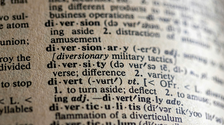Ayim
Can you explain morphemes, allomorphs and allophones in a simple way?
I've just encountered these terms.
please give me a clear definition...I'm somehow confused.
thaaanks dear friends^_^where r my answersssssssssssssssssss?:((
2010年11月9日 13:59
解答 · 14
1
morpheme: small part of a word that adds meaning e.g. in the word "unattractive", 'un-' is the morpheme. morphemes cant be broken up into smaller words, as they are small words of few letters.
allophones: the same phonemes (pieces of sound) pronounced differently, e.g. 'p' in 'pin' is not aspirated, but 'p' in 'spin' IS asiprated
allomorphs: morphemes that vary in sound, but not meaning e.g. 'fished' ('ed' is the morpheme- it sounds like 't' when added to 'fish' to make 'fished,' but alone sounds like 'ed', like short for the name Edward)
hope this helped!!
2010年11月9日
Allophone
Allophones are phonetic variations - different pronunciations - of the same phoneme. Using a different allophone does not change meaning.
Example
The /l/ sound is pronounced differently in ‘love' and in ‘wool'. These two words contain allophones of the phoneme /l/.
In the classroom
It is important to be aware of what allophones and phonemes exist in other languages, as these can cause problems when learning the sounds of English. For example, the /b/ and /v/ phonemes in English are only allophones in Spanish and Spanish learners often have difficulty recognizing the difference. Discrimination activities on minimal pairs of words, distinguished only by the phonemes concerned, can help with this.
http://www.teachingenglish.org.uk/think/knowledge-wiki/allophone
2010年11月10日
Definition
A morpheme: is the smallest meaningful unit in the grammar of a language.
Examples (English)
Unladylike
The word unladylike consists of three morphemes and four syllables.
Morpheme breaks:
un- 'not'
lady '(well behaved) female adult human'
-like 'having the characteristics of'
None of these morphemes can be broken up any more without losing all sense of meaning. Lady cannot be broken up into "la" and "dy," even though "la" and "dy" are separate syllables. Note that each syllable has no meaning on its own.
Dogs
The word dogs consists of two morphemes and one syllable:
dog, and
-s, a plural marker on nouns
Note that a morpheme like "-s" can just be a single phoneme and does not have to be a whole syllable.
Technique
The word technique consists of only one morpheme having two syllables.
Even though the word has two syllables, it is a single morpheme because it cannot be broken down into smaller meaningful parts.
Morphemes may be classified, on the basis of word formation, characteristics into the following types:
see this link
http://www.sil.org/linguistics/GlossaryOflinguisticTerms/WhatIsAMorpheme.htm
.............................................................................
2010年11月10日
Next time you will find this online dictionary very helpful: www.thefreedictionary.com
2010年11月9日
hi
morpheme :
smallest meaningful language unit . In morpheme-based morphology, a morpheme is the smallest linguistic unit that has semantic meaning. In spoken language, morphemes are composed of phonemes (the smallest linguistically distinctive units of sound), and in written language morphemes are composed of graphemes (the smallest units of written language).
allomorphs :
An allomorph is a linguistics term for a variant form of a morpheme. The concept occurs when a unit of meaning can vary in sound (phonologically) without changing meaning. It is used in linguistics to explain the comprehension of variations in sound for a specific morpheme.
allophone :
phonetic variant of a phoneme (Phonetics).In phonetics, an allophone is one of several similar phones that belong to the same phoneme. A phone is a sound that has a definite shape as a sound wave, while a phoneme is a basic group of sounds that can distinguish words (i.e. changing one phoneme in a word can produce another word); speakers of a particular language perceive a phoneme as a single distinctive sound in that language. Thus an allophone is a phone considered as a member of one phoneme.
:)) (:= :))
2010年11月12日
顯示更多內容
還沒找到你要的答案嗎?
寫下你的問題,讓母語者來幫助你!
Ayim
語言能力
英語, 印度語, 義大利語, 波斯語 (Farsi), 土庫曼語, 維吾爾語
學習語言
英語, 印度語, 義大利語, 維吾爾語
你也許會喜歡的文章

Top 6 Mistakes to Avoid with Vocabulary Acquisition
38 讚 · 10 留言

Navigating Your First Job: Do's and Don'ts in the Workplace
47 讚 · 21 留言

What Content to Watch to Acquire Advanced-level Proficiency
79 讚 · 50 留言
更多文章
